Abstract
NUMEROUS authors1–5 have described rare variants of the B blood group antigen which may differ qualitatively from other B antigens. Formaggio6 concluded from his examination of 250 samples of B agglutinogens that differences within the B group were quantitative rather than qualitative. During the performance of 50 per cent end-point hæmagglutination assays of the B-anti-B system7, it was noted that B cells from a Negroid individual were more strongly agglutinated than were those of Caucasoid origin. The probability–log assay curves in Fig. 1 show the difference observed with four doubling dilutions of anti-B serum in an equilibrium system with equal numbers of the two types of B cells of equal freshness. The percentages of cells agglutinated were obtained by the free-cell counting technique described in an earlier paper8 and are plotted against the logarithms of the antiserum concentrations. Since the parallel assay curves indicated that these agglutinogens differed quantitatively rather than qualitatively, the relative ‘strength’ of the B cells could be ascertained from the 50 per cent hæmagglutination end-points or HD50's interpolated from the assay curves. A ratio of the HD50's showed that the Gaucasoid cell possessed only 60 per cent of the agglutinating strength of the Negroid cell. This difference was observed with numerous samples from these same individuals over a period of two years, and thus appears to be an intrinsic property of the agglutinogen from a given individual. The stronger cell was tentatively assigned a value of unity and provisionally designated B1.0 while the weaker Caucasoid cell was termed B0.6 to avoid confusion with the terminology B100, B80, B60 etc., proposed by Hirszfeld9,10 for the Bc (complete) antigen and its transition forms.
Similar content being viewed by others
References
Matta, D., Pub. No. 11, Fac. Med., Univ. Egypt. Cairo (1937).
Mäkelä, O., and Mäkeläa, P., Ann. Med. Exp. Fenn., 33, 33 (1955).
Moullec, J., Sutton, E., and Burgada, M., Rev. Hématol., 10, 574 (1955).
Levine, P., Celano, M. J., and Griset, T., Sixth Cong. Intern. Soc. Blood Transfus., Boston, 132 (1956).
Dunsford, I., Stacey, S. M., and Yokoyama, M., Nature, 178, 1167 (1956).
Formaggio, T. G., Z. Immunforsch., 110, 1 (1953).
Wilkie, M. H., and Becker, E. L., J. Immunol., 74, 192 (1955).
Gibbs, M. B., and Akeroyd, J. H., J. Immunol., 82, 568 (1959).
Hirszfeld, L., J. Immunol., 55, 141 (1947).
Hirszfeld, L., and Amzel, R., Rev. Immunol., 6, 31 (1940).
Author information
Authors and Affiliations
Rights and permissions
About this article
Cite this article
GIBBS, M., AKEROYD, J. & ZAPF, J. Quantitative Sub-Groups of the B Antigen in Man and their Occurrence in Three Racial Groups. Nature 192, 1196–1197 (1961). https://doi.org/10.1038/1921196b0
Issue Date:
DOI: https://doi.org/10.1038/1921196b0
- Springer Nature Limited
This article is cited by
-
Ethnic differences in the expression of blood group antigens in the salivary gland secretory cells from German and Japanese non-secretor individuals
Glycoconjugate Journal (1996)
-
Über die schwache B-Blutgruppeneigenschaft
Blut Zeitschrift für die Gesamte Blutforschung (1965)





